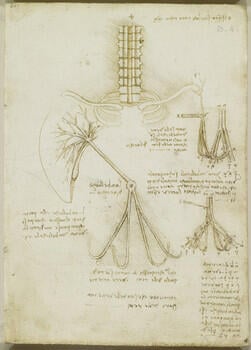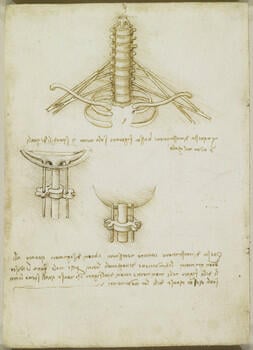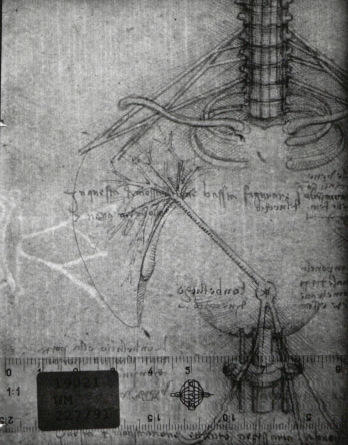-
1 of 253523 objects
The brachial plexus c. 1508
Pen and ink over traces of black chalk | 19.3 x 13.8 cm (sheet of paper) | RCIN 919021
-
A folio from Leonardo's 'Anatomical Manuscript B'. On the recto: a study of the cervical vertebrae, with the clavicle; three diagrammatic drawings of the umbilical blood vessels with notes on the drawings. On the verso: the brachial plexus; two schematised drawings of the junction of the skull and spinal column; notes on the drawings.
The principal drawings on either side of the folio, together with the two drawings on RCIN 919040r, constitute a sequence of schematic diagrams of the brachial plexus (see also 919020v). In the first, on the verso of the present sheet, the seven cervical and first two thoracic vertebrae are shown together with the clavicles and first two pairs of ribs, a gap where the sternum would be, and the brachial plexus on either side of the vertebrae formed from spinal verves. In the second diagram, on 919040r, the vertebrae are sectioned longitudinally to reveal the spinal cord with two parallel ancillary structures within the body of the vertebrae. The third diagram, immediately below that one, depicts this arrangement of nerves in isolation, with the base of the brain included; and the fourth diagram, on the recto of the present sheet, shows the bones alone, with the cavities supposed to house these nerves. On the verso Leonardo also gives two details of the spinal cord and ancillary structures entering the brain.
Though the schematic nature of these diagrams might suggest that they are final expressions of Leonardo’s understanding of the brachial plexus, they are in fact less accurate than the more loosely drawn 919020v. Four spinal nerve roots are shown rather than the correct five, and the pattern of branching in the plexus is excessively simplified. The structures either side of the spinal cord are presumably intended to be the sympathetic trunks, a pair of bundles of nerve fibres and ganglia that run parallel to the spinal cord, from which nerves issue that pass both into the spinal nerves and through the foramina (holes) of the transverse processes of the cervical vertebrae. From the superior ganglion of the trunk, nerves arise and pass into the cranium via the carotid canal, accompanying the internal carotid arteries, but the sympathetic trunks themselves do not enter the cranium. The sympathetic trunks lie anterior to the transverse processes and do not play a significant role in the formation of the brachial plexus; the structures which present in this manner, passing through the body of the cervical vertebrae, are in fact the vertebral veins and arteries. The appearance of the sympathetic trunk changes greatly as it goes from the thorax into the neck: in the thorax it is quite regular, with ganglia and communicating rami at each level, but above the first rib it has only three or so ganglia and can be of much smaller diameter. Leonardo may well have been confused by this transition: even with modern dissection methods, and knowing what to expect, this can be a very difficult area.The drawings in the lower half of the recto are annotated 'del vechio', 'of the old man', and thus constitute another examination of the umbilical vein and arteries of the ‘centenarian’ (see 919027).
Text adapted from M. Clayton and R. Philo, Leonardo da Vinci: Anatomist, London 2012Provenance
Bequeathed to Francesco Melzi; from whose heirs purchased by Pompeo Leoni, c.1582-90; Thomas Howard, 14th Earl of Arundel, by 1630; Probably acquired by Charles II; Royal Collection by 1690
-
Creator(s)
Acquirer(s)
-
Medium and techniques
Pen and ink over traces of black chalk
Measurements
19.3 x 13.8 cm (sheet of paper)
Markings
watermark: Letter A and fragment of crown [Anat MS B]
Category
Object type(s)
Other number(s)


